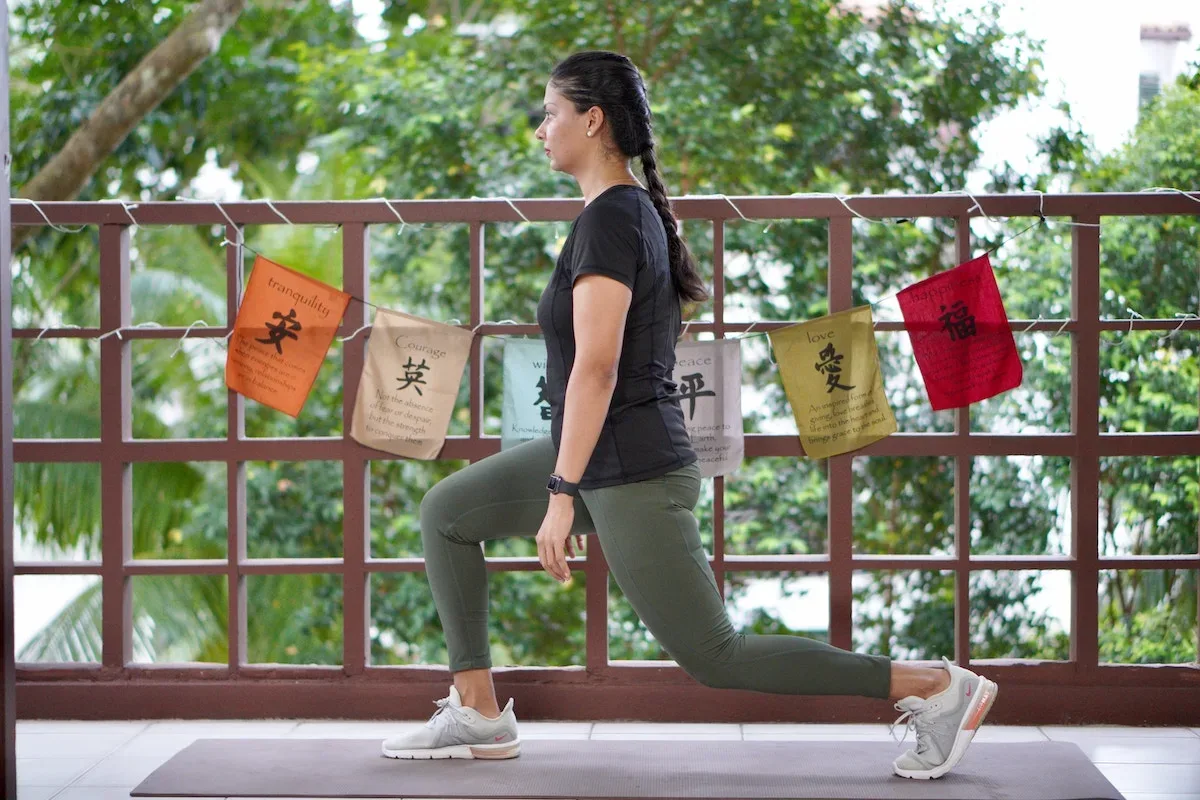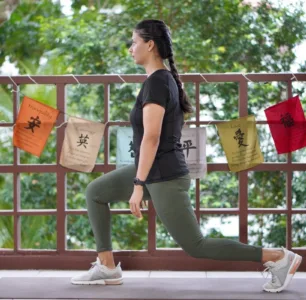Lunges are a popular exercise that primarily target your lower body muscles, including your quadriceps, hamstrings, glutes, and calves. But the benefits of lunges go beyond just building muscle. This exercise is also great for improving your balance, posture, and overall fitness level.
One of the main advantages of lunges is that they help to strengthen your legs. By working multiple lower body muscles simultaneously, lunges provide a comprehensive leg workout that can help you build lean muscle mass and improve your overall lower body strength. As a result, you’ll be better able to perform everyday activities, such as walking, climbing stairs, and lifting heavy objects.
In addition to strengthening your legs, lunges are also excellent for improving your balance and stability. This is because lunges require you to engage your core muscles and maintain proper form throughout the exercise. By doing so, you’ll develop a stronger core and better balance, which can reduce your risk of falls and improve your overall coordination.
Another benefit of lunges is that they can help improve your posture. Many people spend long hours sitting at a desk or hunched over a computer, which can cause poor posture and back pain. However, lunges work to strengthen your back and core muscles, which can help you maintain good posture and reduce the risk of back pain.
To perform a lunge correctly, start by standing with your feet hip-width apart and your hands on your hips or at your sides. Take a big step forward with your right foot, keeping your knee directly above your ankle. Lower your body until your right thigh is parallel to the floor, and your left knee is hovering just above the ground. Pause for a moment, then push back up to the starting position. Repeat on the other side.
In conclusion, lunges are a versatile exercise that offer numerous benefits for your lower body muscles, balance, posture, and overall fitness level. By incorporating lunges into your regular workout routine, you can build lean muscle mass, improve your balance and stability, and reduce your risk of back pain. So the next time you hit the gym, don’t forget to include lunges in your workout!
Which muscles do Lunges develop?
Lunges primarily target your lower body muscles, including your quadriceps, hamstrings, glutes, and calves.
The quadriceps muscles, located on the front of your thigh, are heavily engaged during lunges as you push up from the bent-knee position. The hamstrings, located on the back of your thigh, are also activated during lunges as you lower your body and then return to the starting position.
The glutes, or your butt muscles, are also worked extensively during lunges, particularly when you focus on maintaining proper form and engaging your core muscles. Additionally, the calf muscles are also engaged during lunges as you balance on the balls of your feet while performing the exercise.
How do Lunges improve posture?
Lunges can help improve posture in several ways. First, lunges target your core muscles, including your abdominals and lower back muscles, which are responsible for maintaining good posture. By strengthening these muscles through regular lunge exercises, you can improve your ability to hold yourself upright and maintain proper alignment.
Second, lunges require you to keep your chest up and your shoulders back, which can help correct the rounded shoulder posture that many people develop from sitting at a desk or hunching over a computer. By practicing this upright posture during lunges, you can train your body to maintain good alignment even when you’re not exercising.
Finally, lunges can help improve hip flexibility, which is an important factor in maintaining good posture. Tight hip muscles can pull your pelvis out of alignment and cause your lower back to arch excessively, leading to poor posture and back pain. By performing lunges regularly, you can stretch and strengthen your hip muscles, which can help improve your overall posture and reduce the risk of back pain.
Importance of balance and stability for rugby
Rugby is a physically demanding sport that requires a combination of strength, speed, and agility. However, one aspect of the game that is often overlooked is the importance of balance and stability. Good balance and stability are essential for rugby players to perform at their best and avoid injury.
In rugby, players need to be able to change direction quickly and maintain their balance while being tackled or while tackling others. This requires a high level of body control and stability. Players with good balance are less likely to be knocked off their feet and more likely to stay on their feet after a tackle or collision.
In addition, rugby players need to be able to perform a variety of movements while maintaining their balance, such as running, jumping, and kicking. Good balance and stability allow players to perform these movements more efficiently and with greater precision, which can give them an advantage over their opponents.
Furthermore, good balance and stability can help reduce the risk of injury. Rugby is a sport that involves a high level of contact, and players who are off-balance or unstable are more likely to suffer injuries such as ankle sprains, knee injuries, or even concussions. By improving their balance and stability through training, players can reduce their risk of injury and stay on the field for longer.
Potential issues with Lunges
While lunges are generally a safe and effective exercise, there are some potential issues that people should be aware of.
Firstly, if you have any pre-existing injuries or conditions, such as knee pain or lower back pain, lunges may not be appropriate for you. It’s always a good idea to consult with a doctor or physical therapist before starting any new exercise program.
Secondly, improper form can increase the risk of injury. For example, if you allow your knee to extend past your toes or lean too far forward, you can put excessive stress on your knee joint and increase the risk of knee pain or injury. It’s important to maintain proper form throughout the exercise and avoid overloading any one particular joint or muscle group.
Thirdly, lunges can be challenging for people with poor balance or coordination. If you struggle with balance, it’s a good idea to start with modified or assisted lunges, such as holding onto a chair or wall for support, until you develop more stability.
Finally, lunges can be hard on your muscles, particularly if you’re not used to the exercise or you overdo it. It’s important to start slowly and gradually increase the intensity and duration of your lunges over time. Overtraining or pushing yourself too hard can lead to muscle soreness or injury.
In conclusion, while lunges are generally a safe and effective exercise, it’s important to be aware of potential issues and take steps to minimize the risk of injury. By starting slowly, maintaining proper form, and listening to your body, you can safely and effectively incorporate lunges into your workout routine.
Proper lunge technique
Proper lunge technique is important to ensure you get the most out of this exercise while minimizing the risk of injury. Here are the steps to perform a lunge with proper form:
- Begin by standing with your feet hip-width apart, your core engaged, and your shoulders relaxed.
- Take a large step forward with your right foot, landing with your heel first.
- Lower your body by bending both knees, keeping your torso upright and your abs engaged. Your right knee should be directly above your ankle, and your left knee should be hovering just above the floor.
- Pause briefly, then push back up to the starting position, using your front leg to propel yourself up.
- Repeat on the other side, stepping forward with your left foot and lowering your body down into a lunge.
Here are some additional tips to keep in mind when performing lunges:
- Keep your chest up and your shoulders back throughout the exercise to maintain good posture.
- Make sure your knee does not extend past your toes when lowering into the lunge position.
- Engage your core muscles to stabilize your body and maintain balance.
- Keep your weight evenly distributed between both feet.
- Breathe steadily throughout the exercise, exhaling as you lower your body down and inhaling as you push back up to the starting position.
By following these proper lunge technique guidelines, you can maximize the benefits of this exercise while minimizing the risk of injury.
Lunge variations
There are several variations of lunges that can target different muscle groups and add variety to your workout routine. Here are some lunge variations to try:
- Reverse lunge: Instead of stepping forward, step backward with one foot to perform a reverse lunge. This variation targets the glutes and hamstrings more than the quadriceps.
- Walking lunge: Instead of stepping back to the starting position, bring your back leg forward to step into the next lunge. This variation challenges your balance and coordination.
- Side lunge: Take a wide step to the side, bending one knee while keeping the other leg straight. This variation targets the inner and outer thighs, as well as the glutes.
- Curtsy lunge: Step your back leg behind and to the side of your front leg, bending both knees to lower your body down into a curtsy lunge. This variation targets the glutes and inner thighs.
- Jumping lunge: Jump up explosively from the lunge position, switching legs mid-air to land in a lunge on the other side. This variation increases the intensity and cardiovascular challenge of the exercise.
When incorporating lunge variations into your workout routine, it’s important to start with proper form and gradually increase the intensity and duration of your lunges over time. Additionally, it’s important to choose variations that are appropriate for your fitness level and any pre-existing injuries or conditions. By incorporating lunge variations into your routine, you can challenge your muscles in new ways and keep your workout routine fresh and exciting.

